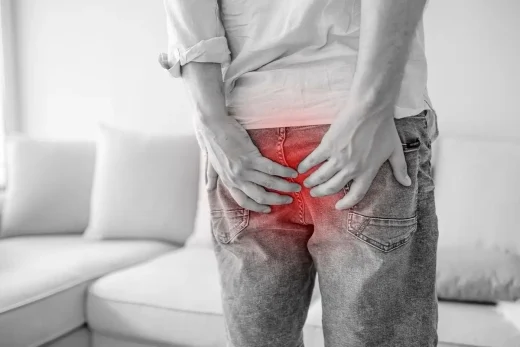This health problem, called hemorrhoids or piles, is common. They are swollen veins that usually appear inside the rectum or outside the anus. These can cause severe pain, itching, or bleeding. Mild symptoms usually improve with home remedies. But for more severe cases, you may need medical treatments.
What are hemorrhoids?
Hemorrhoids, or piles, are vessels that are enlarged inside or outside the anus and rectum. These often cause pain. In more advanced cases, rectal bleeding may also occur. However, every person is born with hemorrhoids. But they do not bother at the beginning. They may only produce symptoms later in life due to nutrition or inactivity.
What are the types of hemorrhoids?
These health problems can occur inside or outside the rectum. However, the types of hemorrhoids depend on where the swollen vein is formed. Types include:
Internal hemorrhoids
If the veins are swollen inside the rectum, they are called internal hemorrhoids. The rectum connects the large intestine to the anus. Piles that form inside this area are usually not painful and do not bleed.
External hemorrhoid
External hemorrhoids are covered with sensitive skin and are located close to the anus. Its usually do not cause pain unless they are thrombosed (a form of clot). And external hemorrhoids treatment is determined depending on the stage at which the hemorrhoids are. In very advanced cases, surgery may be required, especially in thrombosed external hemorrhoid.
Prolapsed hemorrhoids
At the most advanced stage of hemorrhoids, there may be sagging hemorrhoids. These can often cause a sensation of pain and bleeding.
Thrombosed hemorrhoid
Clots are formed inside these hemorrhoidal vessels as a result of blood pooling – accumulation and blockage of the vessels, which is formed by the disruption of blood flow in the external hemorrhoidal vessels located under the skin around the breech. This condition develops quickly.
What’s the difference between hemorrhoids and anal fissures?

Both of these show symptoms such as pain, itching and bleeding. But the cause of piles is swollen veins. The anus is a tear that forms in the lining of the anus. Your doctor decides whether the health problem you are experiencing is anal hemorrhoids or anal fissures. Your doctor can easily understand this with a detailed examination.
What causes hemorrhoids?
You can think of hemorrhoids as a varicose vein. Because it’s just like that. Strains that affect your abdomen or lower extremities cause swelling of the veins in the rectum area. Later, these veins can become inflamed. Hemorrhoids causes include:
- Pelvic pressure from weight gain
- Straining to lift heavy weightlifting
- Chronic constipation
What are the symptoms of hemorrhoids?
Internal hemorrhoids usually do not cause symptoms. But if prolapse occurs, severe pain and bleeding may occur. However, external piles are manifested by various symptoms. These symptoms include:
- Itchy anus.
- Rectal bleeding.
- Pain or ache in the anus.
- Hard lumps near the anus that feel tender.
How are hemorrhoids diagnosed?
Especially painful and bleeding piles cause a lot of discomfort to patients. Often patients who notice these symptoms prefer to go to the doctor. When you go to a doctor with these complaints, your doctor may ask you to have these tests to make a diagnosis:
- Digital rectal exam: Your doctor will first perform a physical examination. Meanwhile, your doctor will check your rectum for problems such as lumps, swelling, or irritation. In the second examination method, after wearing a hygienic glove, the doctor examines the muscle tone and checks the rectum with his finger to feel sensitivity, swelling, lumps, irritation and similar problems. This is called the digital rectal examination method.
- Anoscopy:In this test, a small, lighted tube called an anoscope displays the lining of the anus and rectum.
- Sigmoidoscopy: This test is a method used to evaluate the covering layer (mucosa) and lumen covering the inside of the sigmoid colon, which is a part of the large intestine.
Hemorrhoids treatment
Treatment in this health problem is determined by the severity of the symptoms. First, you may need to make some changes to your lifestyle. These include your eating habits and sports patterns. Piles treatment is generally done with hemorrhoid cream and warm baths. However, most of the patients often ask the question ‘Is there a cure for piles cure in 3 days?’ But the minimum time you need for this treatment is a month. Along with this, hemorrhoid suppositories can also be used. These suppositories reduce pain and sensitivity. But all this applies to mild cases. In more severe cases, surgical treatment may be required.
Hemorrhoid surgery
In low-grade piles that are resistant to drug treatment, hemorrhoidectomy treatment is needed. In addition, surgical treatment methods include band ligation, sclerotherapy or laser operation. The classic surgical operation will require a hospital stay of at least one day. Laser operations require shorter medical care.
Hemorrhoids treatment at home
Home remedies for hemorrhoids usually include suppositories and creams. In mild to moderate cases, doctors usually treat this problem with home remedies. You need to apply these treatments at home for a certain period of time.
How can I prevent hemorrhoids?
You can prevent this problem with plenty of fluid intake, regular exercise and a diet rich in vegetables. However, other precautions you can take include:
- Don’t sit too long.
- Don’t push too hard on the toilet.
- Stay physically active.
- Don’t delay bowel movements, go the toilet when the urge hits.
- Eat more high-fiber foods.
- Use enemas only as recommended by your healthcare provider.
If you have a few of the symptoms associated with this illness contact the Erdem Hospital call centre.
 English
English  Deutsch
Deutsch  Français
Français  Nederlands
Nederlands  Italiano
Italiano  Español
Español  Română
Română  Português
Português  Polski
Polski